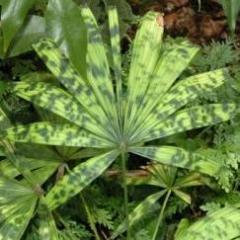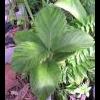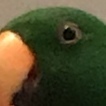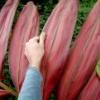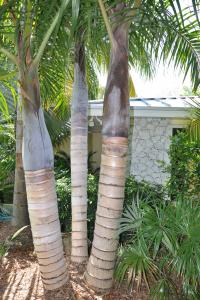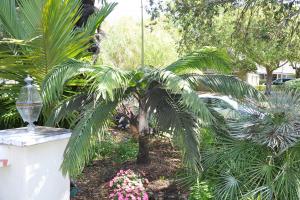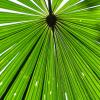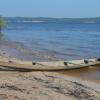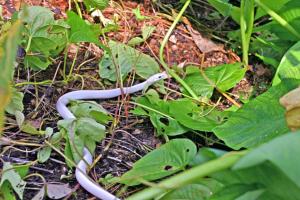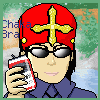Leaderboard
Popular Content
Showing content with the highest reputation on 04/16/2010 in all areas
-
- 12:52PM: There was plenty of food, I know a few people that took more than one trip through the line. - 1:30PM: During and after lunch, tour goers continued to arrive and explore the garden. The property took a bit of navigating to find, as there were many dead end streets nearby. - I noticed tour goers could not get enough of the rose bushes. On my way over to see them getting scrutinized, I stopped after spotting this hidden Burretiokentia hapala. It was well grown and was flowering prolifically, but was hard to see unless you were right next to it. - 1:32PM: "Ohh that one is nice, I like that one." People compared the roses and tried to pick a favorite but soon abandoned that idea. Too many to choose from. Ryan1 point
-
- 12:50PM: I made frequent trips out into the light to see how the lunch crowd was gathering and to use the brilliant sunshine to photograph what palms I could see from the pool patio. The tall coconut palm stretching up in the background is a unique cultivar known as the Red Dwarf Spicata Coconut, Cocos nucifera cv. "Red Dwarf Spicata". The nuts are an apricot, orange-red color and this color extends up into the petioles and rachises. They form on a single, unbranched inflorescence (hence the name spicata) and are arranged in a spiral formation. The tall Neoveitchia storckii to the right made photography of the coconut difficult but interesting. The corner of the patio held an Old Man Palm, Coccothrinax crinita. - After I walked over to get a closer look of the Old Man Palm, I turned around to photograph the other side of the pool patio. Marie Nock walks past one of several planted Telegraph Trees, Polyalthia longifolia var. pendula. I thought about yelling her name to get her attention, but she was dangerously close to the pool's edge and had her eyes set on lunch. The showy palm to the left of center, above the conveniently placed garbage can, is a mature Nicobar Palm, Bentinckia nicobarica. I enjoy telling people that it is also called the "Palm of the Naked People" since 'nicobar' in Malay means "land of the naked people". - This was one of several Vanda orchids that were blooming around the garden. Time for some food... - 12:52PM: I took my place in line and waited for my allotted amount of BBQ goodness. I wondered if any of those cookies would be left by the time I got there. Ryan1 point
-
- 12:47PM: If a plant family or group had an interesting flower of some kind, chances are it had a representative in Jeff Chait's garden. He collects different plant groups that feature a showy flower or fragrance, including Orchids, like this Cattleya variety, also Gardenias and Jasmines. - 12:48PM: This White Elephant Palm, Kerriodoxa elegans, was a show stopper. The crown spanned the width of the area and spilled over into neighboring beds. The leaves were a good 8 feet (2.4m) across and were the largest of any specimen seen on the tour. - The crowded aspect of the garden turned simple photographs into geometric challenges. I had to lean around the trunk of one tree, while kneeling and aiming up to capture this Hyophorbe indica. The collection also had many Crotons, some of which were unnamed seedlings that had naturalized themselves. - 12:49PM: [chomp!] If all these different plant groups weren't enough, Jeff Chait also has a long standing collection of tropical & subtropical fruit trees, squeezed in where ever they could fit. Tour goer and collector Marie Nock bites down on a ripe Jaboticaba, Myrciaria cauliflora, fruit. The heavily shaded tree was in behind to the left. Ryan1 point
-
- 12:46PM: Lots and lots of Roses... Jeff Chait's personal collection was spread all over the yard but most of the rose bushes were here, in the northeast corner of his backyard. He has over four-hundred fifty (450) different rose bushes in his garden! Each one a different cultivar or hybrid and they come complete with their own history. Believe it or not, but this is how the roses look at their worst. They are currently in their "refresh cycle" and had a comparatively small amount of blooms. They had three times as many flowers open a few weeks prior to the tour. Ryan1 point
-
- 12:44PM: The street out front began to fill with the vehicles of tour goers as I made my way up the shaded driveway. The 'rainforest feel' was all around you as beds were filled to capacity, and then some. There was barely enough space for a walk inside one of the beds, just to look around. This area was at the high point in the driveway, not far from the house's front entryway and underneath the giant Talipot Palm, Corypha umbraculifera, seen earlier. This Pelagodoxa henryana is a personal favorite of Jeff Chait's and is often the first palm people ask him about, and vice versa. It has a trunk taller than me and has been flowering and setting seed for several years. Immediately to the right is another Carpoxylon macrospermum, this time planted in the shade and stretching for the light. I caught a whiff of BBQ and decided to go find the source, somewhere out back... - 12:45PM: The center of the backyard featured a large pool and surrounding patio, at the corner of which was this Chambeyronia macrocarpa var. hookeri. The newest leaf was in the final stages of fading to green, and still had a hint of red left in the leaflets. FM. Ron Kiefert (moose knuckle) unknowingly provides scale. - Food. Yum. Garden Tour Host Dr. Jeff Chait himself was at the BBQ helm getting the fire going and cooking a selection of tasty hamburgers and sausages. In addition to the grilled feast, there was traditional picnic fare and an assortment of beverages and desserts. There was a ton of food and hungry tour goers made the best of it. - 12:46PM: Roses... Lots of roses... Palms are not the only passion that gets Jeff Chait out into his yard. Many people who know Jeff for his palm addiction are unaware of his vast knowledge and expertise in Roses, including their horticulture, morphology, habits, history and the thousands of cultivars. He is a world authority on roses and will often travel far and wide judging rose competitions at various flower shows around the planet. Ryan1 point
-
At each garden we visited there were visible signs of cold damage. I just didn't post many photos it as witnessing the damage was bad enough for the palm kindred there on the tour. The cold damage and to a greater extent the freeze we suffered in South Florida was very destructive. It has already been described as the worst winter for S. Florida in 40 years. Jeff Block's Red Sealing Wax Palm was indeed a surprise, but not a complete one knowing the lengths Jeff goes to in order to grow his plants healthy. During the 8 days of real bad cold back in January, the highs in South Florida hovered around 50ºF (10ºC); including a few days where the highs never reached the 50º mark. I would have had even more photos to post of different palms and plants if it wasn't for the cold damage. The current part of the tour is a better example of this, as the cold struck Jeff Chait's garden worst of all. I know on the Forum, members have heard of those collectors who 'push the limits' of what could be grown in their zone and Jeff Chait is no different. He likes to grow popular tropical plants that are very cold sensitive, even by South Florida standards. Many of these plants were either destroyed or severely damaged and left much of his yard unable to be photographed during this tour. I had extensively photographed his great garden two years prior at the SFPS Fall Garden Tour, so I was lucky enough to had captured images of the collection before this years cold. Ryan1 point
-
1 point
-
1 point
-
A few weeks ago we got a visit from the local school of agriculture. They took these pictures. This is the main group of Bismarckia nobilis: There they "caught" a Bismarckia with some unusual flowering. There are two sexes up there - Am I wrong?1 point
-
1 point
-
- 12:29PM: The last palm to catch our attention before leaving for the fourth and final garden, was this Sabal palmetto var. "Lisa". It got its fair share of curious stares and look-overs. - This variety or 'mutant' form of the native Sabal Palm has been slowly gaining popularity as these few cultivated specimens began to show up at sales and in collections. The truncated and abbreviated fan leaves are nearly entire and keep that shape as the palm gets larger. Jeff Searle gives a hand to "Lisa" and held up her newest frond. It was still early in the tour schedule, but we had seen the great collection Tim was putting together and the majority had begun to move on; after thanking Tim for his hospitality... Garden #4: Dr. Jeff Chait's Plant Menagerie - 12:43PM: "Can you tell a plant collector lives here?" The promise of food and a tour of Jeff Chait's renown collection made the short trip to his residence seem even longer. It was my second time visiting his garden and I knew there would still be some surprises for me to see. The sight of his front yard amazes me, even the second time seeing it in person. Every square inch is used, often by more than one plant, and this fact holds true for most of his property. The angle of the sun was perfect for this shot and lights up just about every plant. It would be a topic onto itself just to identify every plant in this photo, but I will point out the larger ones: Starting from the left, the columnar tree is Polyalthia longifolia var. pendula, the massive rounded crown in back belongs to a Talipot Palm, Corypha umbraculifera, down front in center showing trunk is a Pigafetta filaris, to the left of the P. filaris is a Neoveitchia storckii, to the right of the P. filaris showing the top of a crown is a Carpoxylon macrospermum, and a mature Satakentia liukiuensis is near the right edge behind the mailbox. - Zooming in towards the right shows the driveway surrounded by plants. The crowded landscape methodology continues everywhere and I wonder what Jeff Chait would do with more room for his collection. Near the end of the driveway, you can see a characteristic Coconut Palm that seems to be growing out of the bushes at a 90º angle. This palm was blown over by Hurricane Andrew in 1992 and was left to straighten himself back up. It is a unique garden feature by far, but makes this part of the driveway unusable except for foot traffic. The unseen part of the trunk extends quite a distance back into the bush. Ryan1 point
-
I think you've hit the nail on the head saying you have alkaline clay soil. Specifically what is your pH? You're going to have to lower the pH I think, but on clay this is going to be a GREAT deal of hard work. Clay has a high pH buffering capacity. In other words it's soil chemistry is locked so tight, it resists pH changes much much more than say sand. You have to use lots more chemicals per cubic meter to drop the pH on clay than sand. Your palms have iron deficiency as yellowing starts on the new growth and alkaline soils lock iron first. As the soil becomes more acid iron starts to unlock and the plant will start to green up. If you want to give your plants a green look without messing with the soil give them a foliar application of iron chelates. Iron chelates are not effected by soil pH. Use iron sulfate and most of the iron will lock in your soil. But this is a temporary fix. This may sound like a lot of work, but if possible I'd do this. Dig up your poorly growing plants. Remove your bad clay soil and replace with a loamy sand with a lower pH then plant back into that. But don't do any of that until you've tested your actual pH. If it's not too high, you may be able to adjust it back into a more acceptable region. But if it's miles too high don't bother. Also pH is a logarithmic scale. Once you get too far from the mark, you're miles away from where you want to be. They're my thoughts anyway. Best regards Tyrone1 point
-
- 12:23PM: The tour was picking up speed as we took sight of the front yard again. The beds in this area were the oldest of the garden and the most heavily planted. The prominent corner bed near the house featured a large clump of Golden Hawaiian Bamboo, Bambusa vulgaris 'Vittata'. I was standing on a convenient hill created by the roots of a nearby tree. - 12:24PM: Tour Host Tim Blake took a few moments to explain his Banana culture to tour goers. The attendee in pink to the left of Tim was not bored, she blinked because of the flash. - 12:26PM: We were almost back to the driveway and we began to think about the lunch waiting for us at our next stop. Tim can be seen in the far center of the image, walking through the bed and pointing out a few of the palm species. Immediately behind Tim, was a shadowed Chambeyronia macrocarpa and those feather leaves towards the right belong to a Neoveitchia storckii. - I turned to the left slightly to view towards the backyard. The group had begun to thin a tiny bit as people began to leave and head for the last garden of the day's tour. Ryan1 point
-
- 12:18PM: With all the crazy palm and plant people on the tour, I could not find a single person to get on the hammock. It was not the problem of posing, it was the doubt of getting in and out of it. - The area surrounding the seating area was landscaped with an assortment of common and rare palms, including a big grouping of Cabada Palms, Dypsis cabadae near the house. On the right side of the image, partially obscured by tour goers, is a Wallichia oblongifolia. W. densiflora was the older name for this palm, as it was lumped in with W. oblongifolia. - 12:22PM: The majority of Tim Blake's collection was planted in his front yard, so we breezed through the backyard rather quickly. We made our way through another wooden gate and entered the south side of the front yard, where many of his unusual plants were located. Tim can be seen towards the right vigorously explaining the growth of one plant to grower Steve Nock and SFPS President George Alvarez. On the left in center, collector Chris Mahue and Marie Nock check their shoes for the other key evidence of a dog's existence. - 12:23PM: The southern edge of the front yard was lined with a few different Banana cultivars. Tim takes their fruit production very seriously. He had their culture and growth habits down to a science as he knew exactly when they bloomed, how many stems per clump there should be, how much water and fertilizer to apply, when to apply them and even more details. The refined culture meant to get the most amount of bananas per bunch, from the smallest plant possible. Ryan1 point
-
A little over a month ago my wife found this little guy right next to the front steps of the house on the street side of the wall of our carport and entry way. It was a native boa of decent size. One of the neighbors took it away and supposedly let it loose. At least that is the last we heard of it. dk1 point
-
The dazed effect was common to almost everyone attending, but you had to put it aside long enough to get to the next garden. You would not have been alone in your dazed state. Thanks Eric for the identifications, as I could not find more info on that tree fern and it is great to get the name on that Miconia. I am not sure how long in total Jeff Block has been collecting, but the garden he has now is a product of a little over 20 years worth of planting and collecting. Knowing him, he probably got the plants as large as he could, regardless of cost. He did not have many small palms in containers, so he probably plants them soon after he buys them. Ryan1 point
-
1 point
-
1 point
-
1 point

